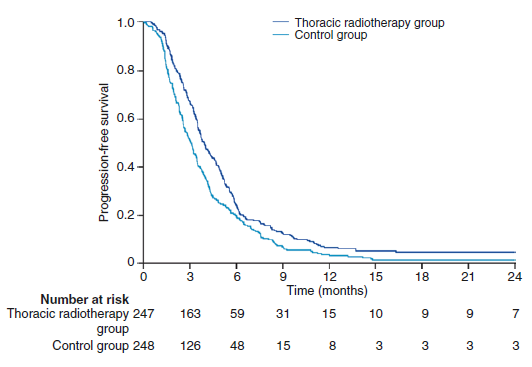RTOG 0937 研究是一项随机的 2 期试验 (2010-2015),评估 ES-SCLC 患者胸部放射治疗 (TRT) 和寡转移灶放疗的作用。该研究纳入了 146 名 1-4 个颅外转移的 ES-SCLC 患者,所有接受化疗任意疗效后,随机分组到 PCI 组和 PCI 及胸部和转移灶放疗组。PCI 予以 25 Gy/10F qd 剂量,颅外放疗予以 45/15F qd(30-40 Gy/10F 也可)。分层因素包括 CR 或 PR,1 个或多个转移灶以及年龄是否大于 65 岁。
该试验在中期分析中因为阴性结果而提早关闭。两组的 OS 均高出预期,但 1 年的 OS,PCI 组 60.1%,PCI+放疗组 50.8%,两者无显著差异。对照组和试验组的原发病变进展发生率分别为 78.1% 和 41.9%。与观察组的 62.5% 相比,TRT 组局部区域进展率为 25.8%。与单纯 PCI 治疗的观察组相比,试验组中因治疗引起的 3 级或更高级的不良事件发生频率更高 (25% vs. 9.5%),其中 4 级毒副作用包括血液学毒性和肺毒性。
然而局部强化治疗组能够延长出现进展的时间,显示针对寡转移灶的放疗以及该放疗模式可能在特定人群有效。故对于多发转移的治疗,依旧充满争议。
研究结论:脑预放联合颅脑外病灶照射相比于单纯脑预放可推迟进展时间,但不能提高 1 年总生存。
Gore EM, et al. Randomized phase II study comparing prophylactic cranial irradiation alone to prophylactic cranial irradiation and consolidative extracranial irradiation for Extensive-Disease Small Cell Lung Cancer (ED SCLC): NRG Oncology RTOG 0937. J Thorac Oncol. 2017;12(10):1561–70.
NRG Oncology RTOG 0937 was a prospec- tive randomized phase 2 trial that was designed to evaluate whether the addition of consolidative radiation therapy to oligometastatic extracranial sites in patients with extensive-stage small cell lung cancer would improve overall survival. A usual up-front management approach for extensive-stage small cell lung cancer is platinum-based chemotherapy followed by
Fig. 3.11 Progression- free survival with and without thoracic irradiation. (Figure from Slotman et al. Lancet 385: 36–42, 2015 with
permission)

prophylactic whole brain irradiation in patients who respond to chemotherapy. This trial random- ized patients to chemotherapy followed by pro- phylactic cranial irradiation plus or minus consolidative radiation therapy for up to four sites of extracranial oligometastatic disease.
Eligible patients had extensive-stage small cell lung cancer without brain metastasis and had one to four sites of extracranial metastasis at time of diagnosis. To be eligible, patients were required to have partial or complete response at least at one site of disease and no sites of disease with progression of cancer following four to six cycles of platinum-based chemotherapy. The rec- ommended radiation therapy to extracranial sites of disease was 45 Gy in 15 fractions. Dose- reduction was allowed to meet normal tissue con- straints. The study randomized 97 patients (of which 86 were eligible for analysis) between 2010 and 2015. The primary outcome measure was overall survival.
Key Point Based on crossing the futility bound- ary for overall survival, the study was closed pre- maturely prior to meeting target accrual. The median overall survival was 15.8 months in patients randomized to not receive consolidative extracranial irradiation and 13.8 months in patients randomized to receive consolidative extracranial irradiation (HR = 1.44, 95% CI 0.82 to 2.53, P = 0.21). The 1-year overall survival was 60.1% in the no consolidative radiation arm and 50.8% in the consolidative radiation arm.
Key Point Median progression-free survival was improved from 2.9 months in the no extra- cranial consolidation radiation arm to 4.9 months in the consolidation radiation arm (P = 0.0148). The addition of consolidative radiation therapy to extracranial sites of locoregional and residual metastatic disease delayed progression of disease at 3 months (14.5% versus 53.3% rate of progres- sion), but this delay was not durable. At 1 year, progression rates were similar between arms at 79.6% and 75%.
Key Point Consolidative radiation to extracra- nial sites of disease changed failure patterns. The
rate of first site of failure at a site present at diag- nosis was decreased from 78.1% to 41.9% with the addition of radiation therapy to extracranial sites of disease.
Key Point There was no significant difference between arms in the rate of grade 3 or higher adverse events (P = 0.24). One patient died of radiation induced pneumonitis.
This was the first randomized trial to evaluate the role of extracranial irradiation to oligometa- static sites in extensive-stage small cell lung can- cer and to report on outcomes and failure patterns. This was a negative study for the primary out- come measure of overall survival. Overall sur- vival in both arms exceeded expectations. In RTOG 0937, the addition of consolidative radia- tion therapy to oligometastatic extracranial sites of disease delayed time to progression and altered failure patterns but did not significantly improve overall survival in patients with extensive-stage small cell lung cancer.
|
|